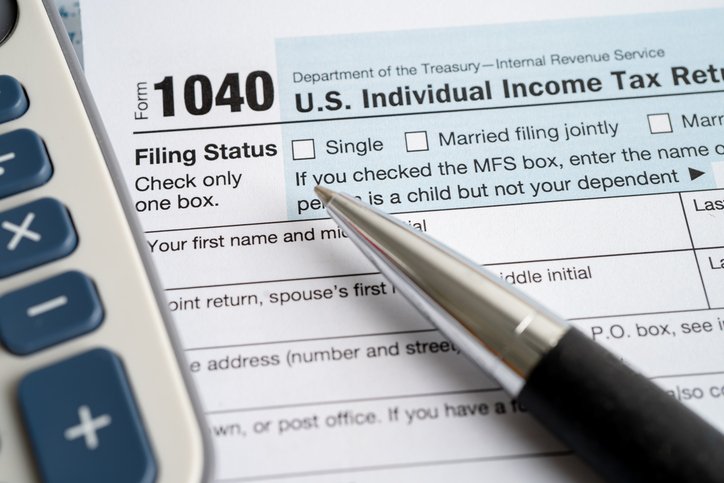Knowing your taxable income helps you make smarter choices about deductions, retirement contributions and how much tax to withhold. It can also prevent surprises at tax time. If your finances are more complex—like having multiple income sources or major life changes—a financial advisor can help you lower your taxes while following IRS rules.
How to Calculate Your Taxable Income
Calculating your taxable income involves more than just tallying your paycheck. The process starts with identifying your filing status and total gross income and then adjusting that number based on allowable above-the-line deductions. That gets to your adjusted gross income (AGI). From there, you subtract either the standard deduction or itemized deductions to get to your taxable income. This is the figure the IRS uses to determine how much tax you owe.
For example, suppose you are a single taxpayer with a salary of $65,000, $1,200 in interest income from investment income and $2,800 in freelance income. You also contributed $4,000 to a traditional IRA and paid $1,500 in student loan interest. This example will help show how to calculate taxable income in a typical scenario.
1. Determine Your Filing Status
Your filing status determines which tax rates apply to you and what your standard deduction will be. The five filing statuses recognized by the IRS are:
- Single: Unmarried taxpayers who do not qualify for other statuses.
- Married filing jointly: Married couples who combine income and file one return.
- Married filing separately: Married couples who file separate returns to keep finances distinct.
- Head of household: Unmarried individuals who pay more than half the cost of maintaining a home for a qualifying dependent.
- Qualifying surviving spouse: Widowed individuals with dependent children, valid for up to two years after a spouse’s death.
In our example, the taxpayer is filing as single. For 2025, the standard deduction for single filers is $15,000. This amount will come into play later when we subtract deductions from AGI to find taxable income.
2. Calculate Your Gross Income
Gross income includes all earnings and sources of revenue that are subject to federal taxation. This can include wages, salaries, tips, interest, dividends, rental income, freelance or gig earnings and unemployment compensation. It is the starting point for determining how to calculate taxable income.
Our example taxpayer earned:
- $65,000 in salary (from a W-2)
- $1,200 in interest income (from a 1099-INT)
- $2,800 in freelance income (from a 1099-NEC)
That brings their total gross income to $69,000.
Remember, it is important to gather all relevant income documents, including W-2s, 1099s and brokerage statements, to ensure no income is missed when calculating gross income.
3. Calculate Your Adjusted Gross Income (AGI)

Adjusted gross income (AGI) is your gross income minus certain “above-the-line” deductions, which are available whether you itemize or take the standard deduction. These adjustments can reduce your taxable income before you even apply standard or itemized deductions.
Some common above-the-line deductions include contributions to traditional IRAs and HSAs, student loan interest (up to $2,500), half of self-employment tax, educator expenses and tuition and fees for qualified education.
- The taxpayer contributed $4,000 to a traditional IRA.
- They paid $1,500 in student loan interest.
- They can also deduct $214, half of their self-employment tax on the freelance income.
These deductions reduce gross income by $5,714. So, the AGI is:
$69,000 – $5,714 = $63,286
This new figure, the AGI, serves as the baseline for the next step: applying deductions.
4. Calculate Your Deductions
Next, you will need to choose whether to take the standard deduction or itemize your deductions. The IRS offers a standard deduction amount that varies by filing status, but if your itemized deductions exceed that amount, it may be better to itemize.
Itemized deductions may include:
- State and local taxes (SALT), up to $10,000
- Mortgage interest
- Charitable contributions
- Qualified medical expenses (exceeding 7.5% of AGI)
- Investment interest
In our example, the taxpayer is single and does not have significant itemizable expenses. The standard deduction for single filers in 2025 is $15,000, so they will use that.
Even if you own a home or donate to charity, it is worth comparing totals each year to see which deduction yields a lower taxable income. A financial advisor can help you evaluate which option is better.
5. Calculate Your Taxable Income
After choosing either the standard or itemized deduction, subtract it from your AGI to determine your taxable income. This is the amount subject to federal taxes, calculated using progressive tax brackets.
Per our example calculation:
- AGI = $63,500
- Standard Deduction (Single filer) = $15,000
- Taxable Income = $48,286
This taxable income is then applied across tax brackets.
2025 Federal Tax Brackets by Filing Status
| Bracket | Single | Married Filing Jointly | Married Filing Separately | Head of Household |
| 10% | $0 – $11,925 | $0 – $23,850 | $0 – $11,925 | $0 – $17,000 |
| 12% | $11,926 – $48,475 | $23,851 – $96,950 | $11,926 – $48,475 | $17,001 – $64,850 |
| 22% | $48,476 – $103,350 | $96,951 – $206,700 | $48,476 – $103,350 | $64,851 – $103,350 |
| 24% | $103,351 – $197,300 | $206,701 – $394,600 | $103,351 – $197,300 | $103,351 – $197,300 |
| 32% | $197,301 – $250,525 | $394,601 – $501,050 | $197,301 – $250,500 | $197,301 – $250,500 |
| 35% | $250,526 – $626,350 | $501,051 – $751,600 | $250,501 – $626,350 | $250,501 – $626,350 |
| 37% | Over $626,350 | Over $751,601 | Over $626,351 | Over $626,351 |
Given our example and with a taxable income of $48,286 for a single filer:
- 10% tax on the first $11,925
- 12% tax on income from $11,926 to $48,286
This means that the taxable income is taxed up to 12%, since it falls under the top threshold of $48,475 for that bracket.
Bottom Line

Learning how to calculate taxable income helps you understand your true tax liability so you can plan accordingly. From collecting income documents and understanding AGI to choosing the right deduction method, each step affects your final tax bill. With a clear view of your taxable income, you can take advantage of tax-saving opportunities and prepare confidently for filing season.
Tips for Tax Planning
- A financial advisor can help you create a plan to manage taxes for your portfolio. Finding a financial advisor doesn’t have to be hard. SmartAsset’s free tool matches you with vetted financial advisors who serve your area, and you can have a free introductory call with your advisor matches to decide which one you feel is right for you. If you’re ready to find an advisor who can help you achieve your financial goals, get started now.
- If you want to know how much your next tax refund or balance could be, SmartAsset’s tax return calculator can help you get an estimate.
Photo credit: ©iStock.com/Andrii Dodonov, ©iStock.com/simpson33, ©iStock.com/sasirin pamai
Read the full article here

















